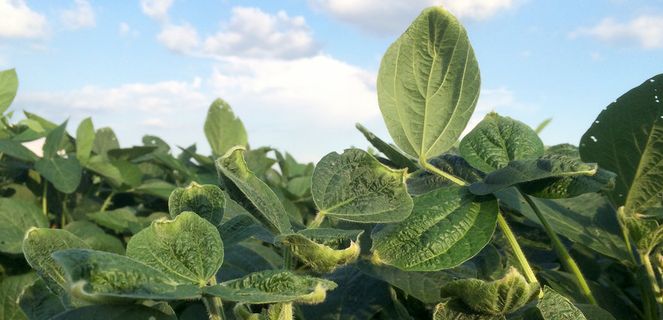Researchers test nanotechnology concept against herbicide ‘drift’
by September 26, 2023 7:02 am 620 views

One of the most controversial issues in Arkansas agriculture is the use of the herbicide dicamba. It is one of the few herbicides that is still effective against pigweed, a pervasive weed that impacts many row crop fields in the Delta.
The problem with dicamba is that it is prone to drift onto adjacent fields and can cause serious damage to crops that haven’t been genetically modified to use the herbicide. Scientists in the Natural State are researching a new solution to this generations-long problem.
The startup CelluDot will receive a nearly $1 million National Science Foundation grant to optimize a nanotechnology product developed by the scientists of the company when they were doctoral students. The goal is to mitigate herbicide drift, and the ongoing research will be done in partnership with the Arkansas Agricultural Experiment Station.
Dr. Joseph Batta-Mpouma, CelluDot’s co-founder and CEO, said the $959,510 National Science Foundation’s Small Business Innovation Research Phase II grant supports the company’s research to optimize and commercialize its nanocellulose-based formulation called BioGrip, for herbicide applications. The all-in-one product has three functions: drift-reducing agent, volatility-reducing agent, and a surfactant, Batta-Mpouma said. BioGrip is made from forestry waste, like sawdust, rather than petroleum-based chemicals.
THE PROBLEM
The Arkansas State Plant Board reported an average of more than 480 drift complaints annually in Arkansas between 2018 and 2022. Nationally, more than 10,500 complaints for dicamba-related herbicide drift alone were received by the U.S. Environmental Protection Agency (EPA) between 2017 and 2021, according to Gurshagan Kandhola, chief technology officer of CelluDot.
More than 1,000 complaints were filed with the Arkansas Plant Board in May 2017 due to dicamba drift. Nearly all of the complaints were filed in Northeast Arkansas. The number of complaints dropped in recent years due to tighter restrictions of its use.
Dicamba has been banned in several states, although it has been used as a herbicide for more than 50 years to manage 200 broadleaf weeds. Hundreds of lawsuits have been filed in connection with the use of the herbicide nationwide during the past seven years.
CelluDot’s product is designed to add weight to the herbicide spray droplets and make them fall more directly on target during field applications. That’s one way it serves as a drift-reducing agent. It is also designed to reduce volatilization of the active ingredient without compromising its efficacy, Kandhola said. Batta-Mpouma said the product provides eco-friendly surfactant benefits to keep the herbicide on the weeds.
Faculty with the experiment station, the research arm of the University of Arkansas System Division of Agriculture, will test the herbicide additive in field trials to produce unbiased performance data.
Batta-Mpouma said the technology has potential applications to other agricultural uses. Farmers growing specialty crops, certified organic plants, and crops not genetically modified to resist specific herbicides have incurred financial losses in the hundreds of millions of dollars due to herbicide drift, Batta-Mpouma said. Using EPA estimates, he noted that up to 70 million pounds of herbicides are lost to the environment each year in the United States due to herbicide drift.
DEVELOPING A POSSIBLE SOLUTION
Early in the development phase, Batta-Mpouma and Kandhola learned through interviews with industry stakeholders that an all-in-one, eco-friendly, and affordable product was needed.
In Phase I of development, Batta-Mpouma said CelluDot validated the product’s technical aspects, such as its ability to reduce herbicide volatility and particle drift and increase spray droplet surface tension and herbicide efficacy.
Batta-Mpouma was a doctoral candidate in the materials science and engineering program at the University of Arkansas when he discovered nanotechnology’s capabilities to help with the herbicide drift problem. He partnered with Kandhola on the research to develop a formulation with drift-reducing properties. At the time, Kandhola was a fellow doctoral student in the biological and agricultural engineering program with a research focus on biomass processing.
Early experimental work included extensive materials testing in Kim’s bio/nano technology laboratory at the Institute for Nanoscience and Engineering of the University of Arkansas.
In Phase II, CelluDot will focus on the field trials with Division of Agriculture researchers to further test the product, complete regulatory approvals, establish commercial relationships with key players in the industry, and scale up production.
PRODUCT TESTING
Division of Agriculture faculty conducting field studies on BioGrip include Nilda Roma-Burgos, weed physiology and molecular biology professor, and Tommy Butts, associate professor and extension weed scientist.
Roma-Burgos said her research team will conduct follow-up experiments in Phase II under low tunnel shelters to generate data supporting refined recommendations for commercial applications on key weed species in commodity crops. The efficacy of two dicamba formulations with BioGrip will be tested on multiple weed species in the greenhouse and field, Roma-Burgos added.
This summer, her team wrapped up Phase I testing of efficacy studies on Palmer amaranth and tall waterhemp, also known as pigweeds. Earlier tests included the effects of adjuvant concentration and nozzle type on drift and volatility of dicamba formulations. Roma-Burgos tested the product’s earliest formulations for volatility drift in greenhouse and field settings using dicamba-sensitive soybean as the test material. She was a scientific advisor in CelluDot’s initial efforts to research and determine BioGrip’s efficacy in controlling herbicide volatilization and particle drift.
Roma-Burgos will coordinate with Butts as he tests the product in spray-chamber and field-scale experiments. His goal is to provide data on droplet size and velocity and generate the necessary information to run EPA drift simulation models required to begin the process of approval for certain tank mixtures. Butts will also conduct a field drift experiment with a commercial sprayer to evaluate the product compared to an industry standard, verifying the drift potential and modeling results from field-collected data.
